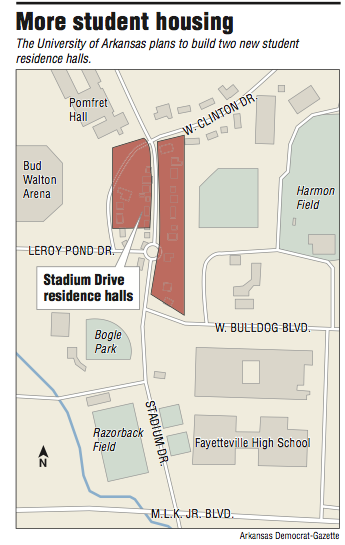FAYETTEVILLE -- A University of Arkansas plan to build two new student residence halls at a cost of about $77 million and convert two smaller dormitories into office space would add 500 beds as the campus seeks to meet student demand for housing after enrollment increases.
UA last opened new dorms three years ago, when 4,339 first-time, degree-seeking freshmen arrived. This fall, the campus has 4,967 freshmen, an increase of about 15 percent compared with 2013 and the most ever for the campus.
Campus housing has a 5,732-bed capacity, a UA official has said, with a few students forced to live in converted study areas at the beginning of school in recent years. The university requires most freshmen to live on campus.
"You can see we have almost no chance for upperclassmen to live on campus given the demand," Chancellor Joe Steinmetz said. In describing the project Thursday to UA System trustees, he cited national data that students living on campus are more likely to stay in school.
The two new Stadium Drive halls would be built on land acquired by UA over the past several years and primarily house first- and second-year students.
UA will also consider using advanced wood construction techniques for the multistory buildings. The university is working with others in the state to explore ways Arkansas can be a leader in the industry.
"It would be the first major project here in the state," Steinmetz said, adding that such a project could be "what's needed to get this industry started." Fayetteville-based Modus Studio, Boston-based Leers Weinzapfel Associates and St. Louis-based Mackey Mitchell Architects have been selected by UA for the project, along with Conway-based Nabholz as a construction manager.
If an approximately $70 million bond issue is approved by trustees next year, Steinmetz said construction would likely start next year and finish by fall 2019. Total construction costs are estimated between $75.5 million and $78.1 million, with university reserves and potentially donations to also be used to pay for the project.
This fall, a lack of rooms forced 17 male students to begin classes while living in converted study rooms, according to UA. A university spokesman said they all had permanent assignments within a week.
In other years, however, more students -- 72 in 2015 -- started classes without a permanent room assignment, with the university also taking longer to find them permanent room assignments.
The cost of double-occupancy rooms in many dormitories has also increased, rising by $310 this fall compared to last year in Gladson-Ripley, the university's least expensive coed dormitory. A bed there costs $5,482 per academic year, not including any meal plan, up 6 percent compared to 2015-16.
Gladson-Ripley and Buchanan-Droke halls would be converted to offices as part of the plan, Steinmetz said, describing the new Stadium Drive halls as priced "at the top tier of our housing rate structure." Other residence halls will stay at lower prices, he said.
In plan documents from 2006 and 2013, the university described the area east of Bud Walton Arena as a potential option for new construction.
The site area has been identified to include land both east and west of Stadium Drive, but the number of acres for the project remains unknown pending further design work, said Mike Johnson, UA's assistant vice chancellor for facilities.
The area considered for the project partially borders the Fayetteville High School campus.
"We have no current nor future stated/unstated desire to purchase any of the FHS property contiguous to the Stadium Dr area UA property," Johnson said in an email.
In 2008, UA offered $50 million to purchase the entire 40-acre Fayetteville High site but later withdrew the offer after the local school board declined to accept the bid.
Matthew Wendt, superintendent for Fayetteville Public Schools, said he had no concerns about the project, calling UA a good neighbor. He added that since UA's offer the high school has been extensively renovated.
The additional land costs for the dorm site include purchases of $357,500 and $286,000 made this year with approval from UA System trustees, according to James Ezell, a member of UA's property management staff. Land records did not appear to list a purchase price for all parcels included in the site location, but records did show a $204,000 transaction last year and a $210,000 purchase in 2010.
For the project, the university expects to add 525 parking spaces based on a calculation of 0.75 spaces per resident. Students have complained about parking in recent years as the university's enrollment has increased.
The project also calls for a renovated student dining hall at a nearby dormitory, Pomfret Hall. Other plans include "retail dining" and advising offices designed to extend services to the southern part of campus, according to UA.
Separately, a new sorority house planned for northeast of campus, will be funded through Delta Gamma Fraternity financing as well as private donations, according to the university. The project, which is expected to house 85 students, is expected to cost $11.5 million to $12.5 million and be substantially completed by May 2019, according to the university.
Several fraternity and sorority housing renovation and construction projects have been completed recently, including the opening of a new house this fall east of campus for the Kappa Alpha fraternity. An estimated $12.5 million to $13.5 million renovation and expansion of the Delta Delta Delta sorority house has also been approved, with funding to come from private financing and donations.
Metro on 11/11/2016
